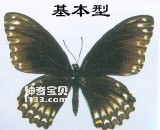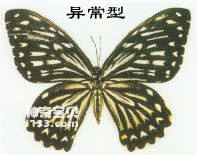This species has different types in southern China: the basic type Chilasa clytia f.clytia (Linnaeus) (no yellow and white stripes on each wing cell on the wing surface); the abnormal type Chilasa clytia f.disimilis (Linnaeus) (wings There are yellow and white stripes on each wing chamber on the wing surface); Chilasa clytia f. dissimilima Evans (the wing color is darker, there are narrow white stripes on each wing chamber on the wing surface, and the yellow spot on the edge of the hind wing becomes smaller).

Wingspan is 80~101mm. Male and female dimorphism. The wings of the male butterfly are dark brown or tan, with the base half dark. There is one row of spots on the outer edge and sub-outer edge of the forewing; the yellowish-white spots at the apex and sub-apex corners are larger, and some of the spots in the sub-outer edge are misplaced. The outer edge of the hind wings is wavy, with light yellow spots in the concavities of the waves, and 1 to 2 rows of crescent-shaped or prismatic spots on the sub-outer edge. The brown spots on the back of the wings appear very clear. The wings of the female butterfly are black or dark brown, and all the markings are light yellow. The outer and sub-outer edge areas of the forewing markings are the same as those of the male butterfly. There are radial stripes at the base and sub-base. The markings on the middle and middle back areas are scattered and vary in size. The outer edge and sub-outer edge of the hind wings are the same as those of the male butterfly. The other markings are arranged radially along the veins, and most of the markings are tooth-shaped at the ends. The reverse side of the wings is similar to the front side, but the markings are clear and the color is thick. This species of swallowtail butterfly often has white spots on its wings.

Host: Lauraceae, Lauraceae, Litsea glutinosa and other plants.
Biology: Adults are common in low-altitude flatlands and hilly areas. They circle high in tropical forests or over hills and fly away when frightened. They fly slowly and with strong flying power. On sunny days when the monsoon comes, they fly for several hours before resting; sometimes they take the initiative. Attack other butterflies and then run away. Adult beetles like to visit flowers. Eggs are laid on the dorsal and ventral surfaces of new shoots and young leaves of the host plant, or on petioles and twigs. Larvae inhabit the front side of leaves from the first instar to the last instar. Mature larvae pupate on branches thicker than a finger, tree trunks, or nearby buildings.

Distribution: Sichuan, Yunnan, Hainan, Guangdong, Guangxi, Fujian, Taiwan, Hong Kong; India, Bhutan, Nepal, Myanmar, Thailand, Pakistan, Philippines, Malaysia.
animal tags:
We created this article in conjunction with AI technology, then made sure it was fact-checked and edited by a Animals Top editor.